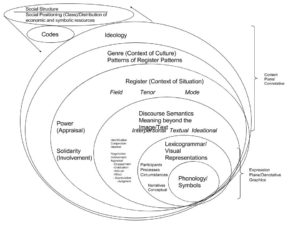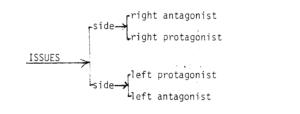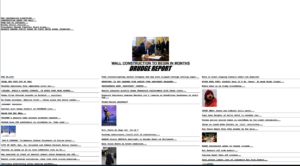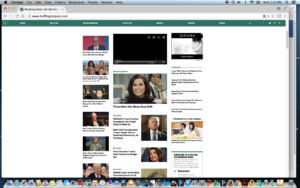In their groundbreaking book Reading Images: The Grammar of Visual Design, Kress and van Leeuwen (2006) write that “Just as grammars of language describe how words combine in clauses, sentences and texts, so our visual ‘grammar’ will describe the way in which depicted elements—people, places and things—combine in visual ‘statements’ of greater or lesser complexity and extension” (p. 1). Following their work using SFL, I view the clause (the configuration of participants, processes, and circumstances) as the basic unit of experience, which also applies to images in terms of the construction of visual arguments as well. Designers create visual arguments using the available semiotic resources of their social contexts. I do not believe images can be created without some linguistic or contextual reference, as by definition, visual arguments are socio-semiotic constructs.
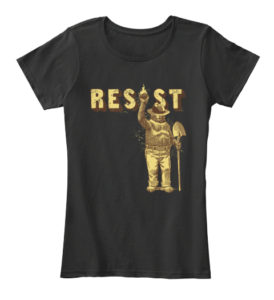
Smokey Bear Resist T-Shirt
When discussing the three sites of visual production—the technological, compositional, and social—Rose (2012) uses the work of Marxist and critical geographer David Harvey to help elucidate, in Harvey’s terms, The Condition of Postmodernity (1989) of our contemporary social environment. Here, I will briefly apply a “Harvey-ian” lens to the above image of Smokey The Bear as an activist, created after a faction of the National Park Service recently went “rogue.” Harvey (2005) argues that neoliberalism has radically restructured the economic and social landscape, creating a ruling elite of tech CEOs and billionaires, whose hegemonic ideology frames an interventionist, neo-imperialist foreign policy as a radical form of personal liberation and social justice. Central to neoliberalism is the co-option of 1960s activist discourses and new social movements centered on civil rights and sexual and identity politics, to legitimize and normalize state and global control in the hands of a few elites. The Smokey The Bear Resist image plays into a radical chic neoliberal doctrine of pseudo-activism, by coding a message in support of maintaining the status quo (a decades-long politicized techno-environmental science agenda) as an edgy social justice issue. Harvey’s method allows for a deeper, ideological critique of internet activism that would be nearly impossible to uncover from the mere denotative level of the visual argument. The Marxist irony is not lost, as this supposedly anti-consumerist message is being sold on t-shirts for $22.99.
Why This Method For This Artifact?
The theoretical methodology I am developing is a Frankentheory that needs to be capable of analyzing visual texts as well as their dialectical relations to culture. This notion of modeling both a text and its social relations comes from SFL, especially Firth, Hasan, and Halliday’s argument that language can only be understood within its context of cultural-use. Hasan (2016) writes, “the relation between language and society is dialectical. Language creates, maintains, and changes human society while this stable and yet forever changing society puts pressure on linguistic resources for making a specific range of meanings, with consequences that are far-reaching indeed for both language and society” (p. 12).
To analyze memes as visual texts I will be using SFL, specifically the stratified view of language pictured below. This model views language from the ground up at various stratified levels, beginning with the minutest level of phonology, to lexicogrammar, to discourse semantics (the text as a whole), to register (the context of situation dealing with field, tenor, and mode variables), to the context of culture (genre, a pattern of register patterns), to ideology. The level of ideology has been added to take into account patterns of meaning that cannot be understood by the text, register, or genre, alone. I will be applying this method of textual analysis to memes. Here the expression plane of phonology and grammar is represented by visual signifiers, while the content plane that goes beyond the text—register, genre, and ideology— will be considered the signified. Register analysis will be essential for understanding visual narratives in terms of the field (the experiential level of participants, processes, and circumstances), tenor (the emotional level, attitude, solidarity, power), and mode (the channel(s) of communication). Following Poynton (1992), ideology will be considered as dealing with evaluation (some form of judgment) and in terms of binary oppositions— “male/female, capitalism/socialism, war/peace,” etc. (p.10).
Yet, just analyzing visual texts with this stratified model of language is not enough to gain a full understanding of the dialectical relations between visual texts and culture, so from the cultural perspective I will be drawing from the work of cultural theorists such as Stuart Hall, Raymond Williams, Basil Bernstein, and Jean Baudrillard. This methodology should provide a more fully contextualized and dialectical framework for understanding the role ideology plays in the construal of visual texts in our culture.
The method used to analyze this particular artifact draws from the cultural studies side of my framework by operationalizing several of Harvey’s concepts in terms of Neoliberalism and pseudo-activism to better understand the connotative meaning, motivations, and power relations, behind social media activism.
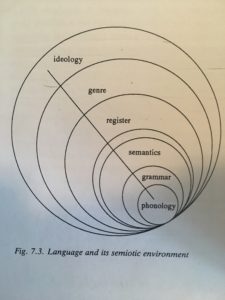
Language and its semiotic environment (Martin, 1992, p. 496)
What Did The Analysis Reveal?
The analysis reveals a deeper ideological level embedded in the text that is difficult to retrieve solely from the denotative level. At the denotative level, the image conveys an unproblematic liberal humanist message about standing up for one’s beliefs and the environment against those willing to destroy it. At a deeper level, however, the analysis reveals a complex ideological system with possibly unstated ulterior motives. These ulterior motives can manifest as “weaponized discourse,” think the “meme wars,” unduly influencing viewers with sophisticated ideologies at an almost subconscious level. Within this framework, social structures generate specific codes based on class-specialization, giving rising to various forms of consciousness. In general, members of the old middle class believe in a strong classification (such as border walls, extreme vetting), while the new middle class believes in weak classification (open borders, weak categorizations of gender roles, etc.). These sorts of class-strata differences in terms of code, realized through visual texts such as memes, lead to ideological conflicts within the the middle class, potentially causing economic, social, and ideological divisions.
What Does The Analysis Miss?
At this point in time, this analysis misses the “how” of visual texts. From a semiotic perspective, how does the image of Smokey the Bear convey its specific denotative and ideological messages? This is where visual analysis using SFL comes into play, especially a register analysis of field, tenor, and mode. But as stated earlier, mapping the ideological plane is necessary for a full understanding of the text, so that is why a dialectical theory of text and culture is necessary.
References
Harvey, D. D. (2006). A brief history of Neoliberalism. Oxford: Oxford University Press, USA.
Hasan, R. (2016). Context in the system and process of language (J. Webster, Ed.). Sheffield, UK: Equinox.
Kress, G. R., & Van Leeuwen, T. (2006). Reading images: The grammar of visual design (2nd ed.). London: Taylor & Francis.
Poynton, C. (1992). Language and gender: making the difference. Geelong, Australia: Deakin University Press.
Rose, G. (2011). Visual methodologies: An introduction to the interpretation of visual materials (2nd ed.). Thousand Oaks, CA: SAGE Publications.

